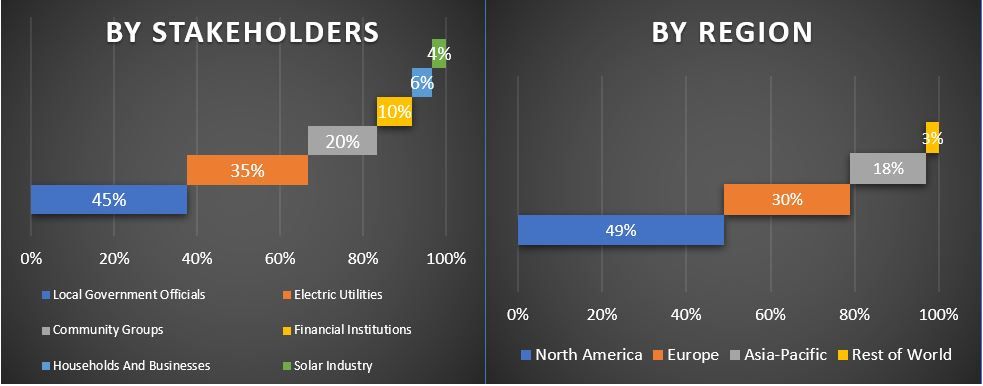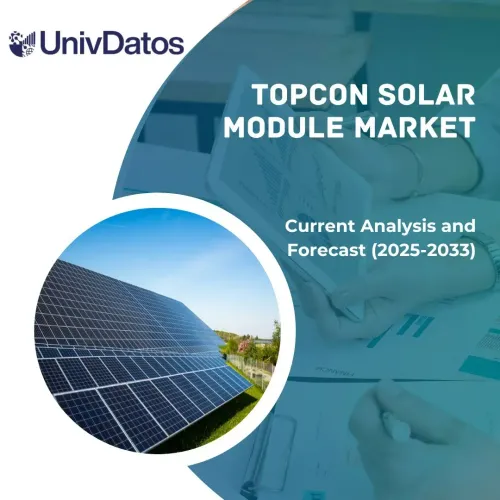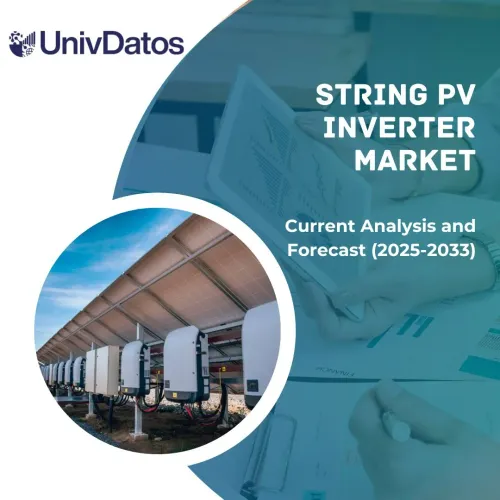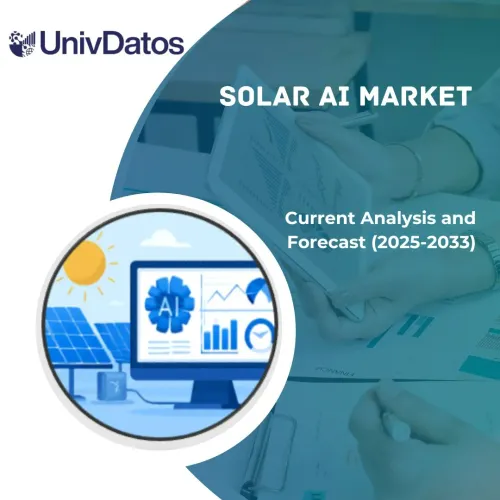- Inicio
- Acerca de nosotros
- Industria
- Servicios
- Leyendo
- Contáctenos
Mercado de Celdas Solares: Análisis Actual y Pronóstico (2021-2027)
Énfasis en la Tecnología (Sistemas Fotovoltaicos, Sistemas de Energía Solar Concentrada); Módulos Solares (Monocristalinos, Policristalinos, Telururo de Cadmio, Celdas de Silicio Amorfo, Otros); Aplicaciones (Residencial, Comercial, Industrial, Otros); Usuario Final (Generación de Electricidad, Iluminación, Calefacción, Carga); Región y País
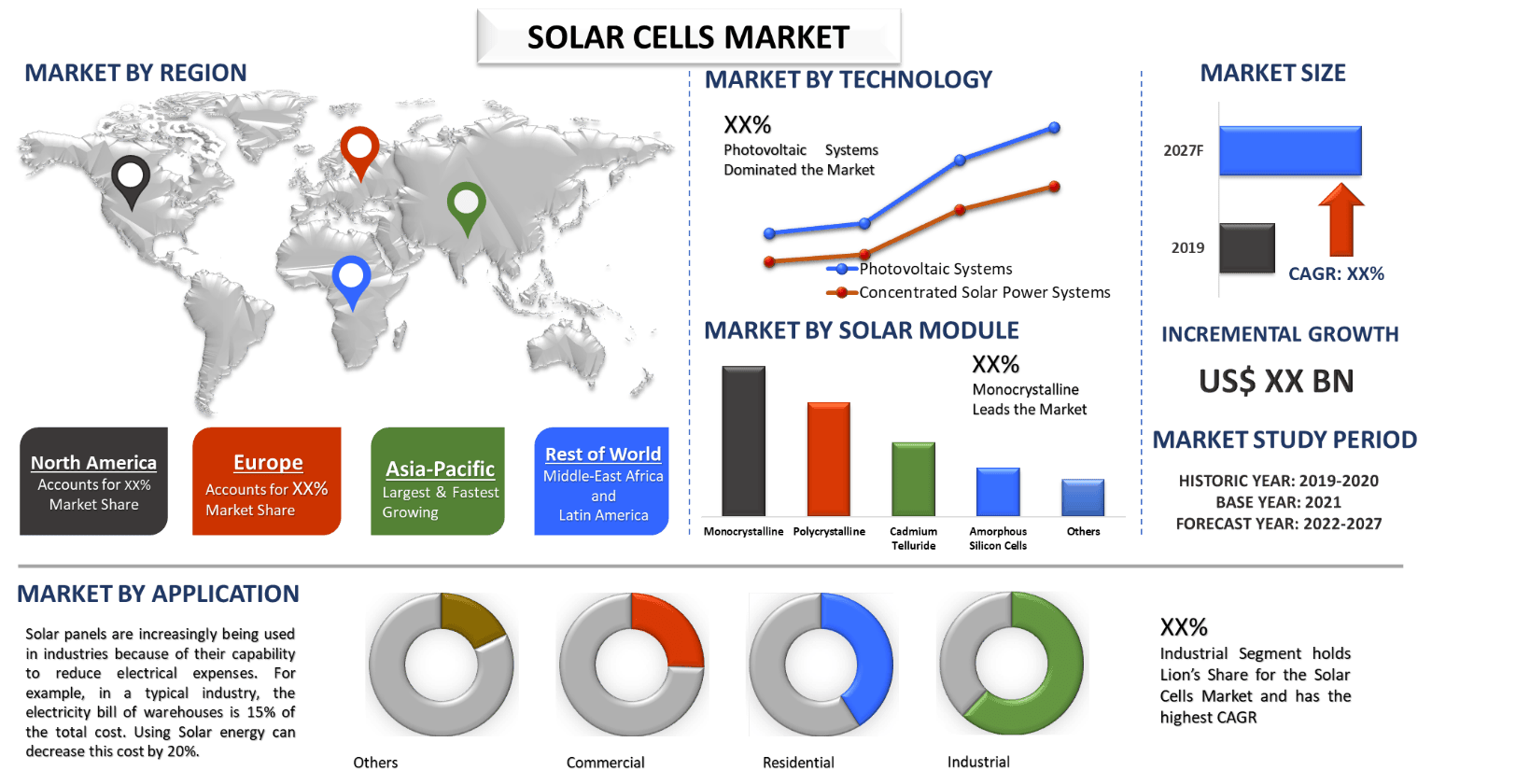
El mercado de Celdas Solares se valoró en ~US$ 65 mil millones en 2020 y se espera que crezca a una CAGR de ~10% durante el período de pronóstico (2021-2027).Los paneles solares recolectan energía renovable limpia de la luz solar y la convierten en electricidad que se utiliza para alimentar cargas eléctricas. Los paneles solares están hechos de varias celdas solares combinadas con capas de silicio, fósforo (carga negativa) y boro (carga positiva). Los paneles solares inician la corriente eléctrica absorbiendo fotones que sacan electrones de sus órbitas atómicas y forman un campo eléctrico que luego atrae estos electrones libres hacia una corriente direccional. Todo este proceso se conoce como el efecto fotovoltaico. Los paneles solares colocados en el techo de una casa transfieren toda la electricidad a la red eléctrica principal, que puede almacenarse y utilizarse por la noche. En una red bien equilibrada, la energía es generada por paneles solares durante el día, que se almacena y luego se puede utilizar por la noche. En algunos países, la energía adicional generada por los propietarios de paneles solares en casa puede venderse a los productores de electricidad.
SOLICITAR PDF DE MUESTRA GRATUITA
La popularidad de los paneles solares está aumentando a medida que se han vuelto asequibles. El costo de los sistemas fotovoltaicos solares ha disminuido de US$ 0.37/kWh en 2010 a US$ 0.085/kWh en 2018 y se espera que disminuya aún más a US$ 0.05-0.01/kWh para 2050. Además de esto, los cambios en las políticas gubernamentales y la concienciación sobre los beneficios de la energía sostenible también están influyendo en el crecimiento del mercado. Si se pueden producir 8.500 GW de energía solar, esto generará más del 25% de los requisitos de electricidad para 2050 y mitigará 4.9 Gt de emisiones de CO2. Además, con la creciente demanda de electricidad y el bajo costo de mantenimiento de los paneles solares, son más baratos a largo plazo, lo que los convierte en una buena inversión en los hogares privados. A largo plazo, uno puede ahorrar hasta US$ 43,735 en electricidad utilizando paneles solares en 20 años. Aparte de esto, la eficiencia de los paneles solares también ha aumentado significativamente con el tiempo. Los sistemas fotovoltaicos multicristalinos alcanzaron el 17% de eficiencia y los sistemas fotovoltaicos monocristalinos han alcanzado el 18% de eficiencia desde 2018. Todos estos desarrollos están impulsando el crecimiento en el mercado de celdas solares.
Costos de Generación de Electricidad de Varias Fuentes en Europa (US$)
Abengoa Se, Acciona S.A., Canadian Solar, Inc., Esolar, Inc., United Renewable Energy Co. Ltd., Sunpower Corporation, Kaneka Corporation, Tata Power Solar Systems Ltd., Wuxi Suntech Power Co., Ltd. y Brightsource Energy, Inc. son algunos de los actores prominentes que operan en el mercado de Celdas Solares. Varios M&A junto con asociaciones han sido emprendidos por estos actores para facilitar a los clientes productos/tecnologías innovadores y de alta tecnología.
Información Presentada en el Informe
“Entre la Tecnología, el segmento Fotovoltaico posee la mayor cuota”
Basado en la Tecnología, el mercado de Celdas Solares se segmenta en Sistemas Fotovoltaicos y Sistemas de Energía Solar Concentrada. Entre la tecnología, el segmento de Sistemas Fotovoltaicos del mercado de Celdas Solares se valoró en US$ XX mil millones en 2020 y es probable que alcance los US$ XX mil millones para 2027 y está creciendo a una CAGR de XX% de 2021-2027. Los Sistemas Fotovoltaicos (FV) están compuestos por uno o más paneles solares que se combinan con un inversor y algunos componentes eléctricos y mecánicos que utilizan la energía del sol para generar electricidad. La capacidad fotovoltaica solar global ha crecido de 5 GW en 2005 a alrededor de 509.3 GW en 2018.
“Entre los Módulos Solares, el Segmento Monocristalino posee la mayor cuota”
Basado en el Módulo Solar, el mercado de Celdas Solares se segmenta en Monocristalino, Policristalino, Telururo de Cadmio, Celdas de Silicio Amorfo y Otros. Entre el Módulo Solar, el segmento Monocristalino representó una valoración de mercado de US$ XX mil millones en 2020 y se espera que alcance los US$ XX mil millones para el año 2027, a una CAGR de XX% durante el período analizado. Los paneles monocristalinos son paneles de color negro plano único, lo que los hace populares entre los propietarios de viviendas debido a su mejor diseño y apariencia. Los paneles monocristalinos tradicionalmente contienen de 60 a 72 celdas solares dependiendo del tamaño de los paneles.
“Entre la Aplicación, el Segmento Industrial posee la mayor cuota”
Basado en la Aplicación, el mercado de Celdas Solares se segmenta en Residencial, Comercial, Industrial y Otros. El segmento industrial generó ingresos de US$ XX mil millones en 2020 y se espera que crezca a una CAGR de XX% durante el período de pronóstico para alcanzar una valoración de mercado de US$ XX mil millones para 2027F. Los paneles solares se utilizan cada vez más en las industrias debido a su capacidad para reducir los gastos eléctricos. Por ejemplo, en una industria típica, la factura de electricidad de los almacenes es el 15% del costo total. El uso de energía solar puede disminuir este costo en un 20%.
“Entre el Usuario Final, el Segmento de Generación de Electricidad posee la mayor cuota”
Basado en el Usuario Final, el mercado de Celdas Solares se segmenta en Generación de Electricidad, Iluminación, Calefacción y Carga. Entre el usuario final, el segmento de Generación de Electricidad del mercado de Celdas Solares se valoró en US$ XX mil millones en 2020 y es probable que alcance los US$ XX mil millones para 2027 y está creciendo a una CAGR de XX% de 2021-2027. Una sola celda fotovoltaica genera alrededor de 2 vatios de electricidad. Cientos de celdas solares se pueden conectar para formar paneles solares que luego pueden generar miles de kilovatios de energía eléctrica. La mayoría de las celdas fotovoltaicas actuales tienen una eficiencia de alrededor del 15-20%.
“Asia Pacífico representa uno de los mercados más grandes del mercado de Celdas Solares”
Para una mejor comprensión de la dinámica del mercado de Celdas Solares, se realizó un análisis detallado para diferentes regiones en todo el mundo, incluyendo Norteamérica (EE. UU., Canadá y el Resto de Norteamérica), Europa (Alemania, Francia, Italia, Reino Unido, España y el Resto de Europa), Asia-Pacífico (China, Japón, India, Australia y el Resto de APAC) y el Resto del Mundo. Asia Pacífico dominó el mercado y obtuvo alrededor del XX% de la cuota de mercado debido a la creciente demanda de electricidad en la región.
Razones para comprar este informe:
- El estudio incluye el dimensionamiento del mercado y el análisis de pronóstico validados por expertos clave de la industria autenticados
- El informe presenta una revisión rápida del rendimiento general de la industria de un vistazo
- El informe cubre un análisis en profundidad de los pares prominentes de la industria con un enfoque principal en las finanzas comerciales clave, la cartera de productos, las estrategias de expansión y los desarrollos recientes
- Examen detallado de los impulsores, restricciones, tendencias clave y oportunidades que prevalecen en la industria
- El estudio cubre exhaustivamente el mercado en diferentes segmentos
- Análisis en profundidad a nivel regional de la industria
Opciones de personalización:
El mercado de Celdas Solares se puede personalizar aún más según el requisito o cualquier otro segmento del mercado. Además de esto, UMI entiende que usted puede tener sus propias necesidades comerciales, por lo tanto, no dude en conectarse con nosotros para obtener un informe que se adapte completamente a sus necesidades.
Tabla de contenido
El análisis del mercado histórico, la estimación del mercado actual y el pronóstico del mercado futuro del mercado de Celdas Solares fueron los tres pasos principales realizados para crear y analizar la adopción de Celdas Solares en las principales regiones a nivel mundial. Se realizó una exhaustiva investigación secundaria para recopilar los números históricos del mercado y estimar el tamaño actual del mercado. En segundo lugar, para validar estos conocimientos, se tomaron en consideración numerosos hallazgos y supuestos. Además, también se realizaron exhaustivas entrevistas primarias, con expertos de la industria en toda la cadena de valor del mercado de Celdas Solares. Después de la suposición y la validación de los números del mercado a través de entrevistas primarias, empleamos un enfoque de arriba hacia abajo/abajo hacia arriba para pronosticar el tamaño completo del mercado. Posteriormente, se adoptaron métodos de desglose del mercado y triangulación de datos para estimar y analizar el tamaño del mercado de segmentos y subsegmentos a los que pertenece la industria. La metodología detallada se explica a continuación:
Análisis del Tamaño Histórico del Mercado
Paso 1: Estudio Profundo de Fuentes Secundarias:
Se realizó un estudio secundario detallado para obtener el tamaño histórico del mercado de las Celdas Solares a través de fuentes internas de la empresa, comoinforme anual y estados financieros, presentaciones de rendimiento, comunicados de prensa, etc.y fuentes externas, incluyendorevistas, noticias y artículos, publicaciones gubernamentales, publicaciones de la competencia, informes del sector, bases de datos de terceros y otras publicaciones creíbles.
Paso 2: Segmentación del Mercado:
Después de obtener el tamaño histórico del mercado del mercado de Celdas Solares, realizamos un análisis secundario detallado para recopilar información histórica del mercado y compartirla para diferentes segmentos y subsegmentos para las principales regiones. Los principales segmentos incluidos en el informe como tecnología, módulo solar, aplicación y usuario final. Además, se realizaron análisis a nivel de país para evaluar la adopción general de energía renovable en esa región.
Paso 3: Análisis de Factores:
Después de adquirir el tamaño histórico del mercado de diferentes segmentos y subsegmentos, realizamos un detalladoanálisis de factorespara estimar el tamaño actual del mercado de Celdas Solares. Además, realizamos un análisis de factores utilizando variables dependientes e independientes, como el aumento de la eficiencia de las celdas solares y la reducción de su costo de mantenimiento. Se realizó un análisis exhaustivo de los escenarios de la oferta y la demanda, considerando las principales asociaciones, fusiones y adquisiciones, la expansión comercial y los lanzamientos de productos en el sector de Celdas Solares en todo el mundo.
Estimación y Pronóstico del Tamaño Actual del Mercado
Dimensionamiento Actual del Mercado:Basándonos en información útil de los 3 pasos anteriores, llegamos al tamaño actual del mercado, los actores clave en el mercado de Celdas Solares y las cuotas de mercado de los segmentos. Todas las cuotas porcentuales requeridas, las divisiones y los desglose del mercado se determinaron utilizando el enfoque secundario antes mencionado y se verificaron a través de entrevistas primarias.
Estimación y Pronóstico:Para la estimación y el pronóstico del mercado, se asignaron pesos a diferentes factores, incluyendo impulsores y tendencias, restricciones y oportunidades disponibles para las partes interesadas. Después de analizar estos factores, se aplicaron técnicas de pronóstico relevantes, es decir, el enfoque de arriba hacia abajo/abajo hacia arriba, para llegar al pronóstico del mercado para 2027 para diferentes segmentos y subsegmentos en los principales mercados a nivel mundial. La metodología de investigación adoptada para estimar el tamaño del mercado abarca:
- El tamaño del mercado de la industria, en términos de valor (US$) y la tasa de adopción de Celdas Solares en los principales mercados a nivel nacional
- Todas las cuotas porcentuales, divisiones y desglose de los segmentos y subsegmentos del mercado
- Actores clave en el mercado de Celdas Solares en términos de productos ofrecidos. Además, las estrategias de crecimiento adoptadas por estos actores para competir en el mercado de rápido crecimiento
Validación del Tamaño y la Cuota de Mercado
Investigación Primaria: Se realizaron entrevistas en profundidad con los Líderes de Opinión Clave (KOL), incluidos los Ejecutivos de Alto Nivel (CXO/VP, Jefes de Ventas, Jefes de Marketing, Jefes de Operaciones y Jefes Regionales, Jefes de País, etc.) en las principales regiones. Los resultados de la investigación primaria se resumieron y se realizó un análisis estadístico para probar la hipótesis planteada. Las aportaciones de la investigación primaria se consolidaron con los hallazgos secundarios, transformando así la información en conocimientos prácticos.
Distribución de los Participantes Primarios en Diferentes Regiones
Ingeniería de Mercado
Se empleó la técnica de triangulación de datos para completar la estimación general del mercado y llegar a cifras estadísticas precisas de cada segmento y subsegmento del mercado de Celdas Solares. Los datos se dividieron en varios segmentos y subsegmentos después de estudiar varios parámetros y tendencias en las áreas de tipo y su tipo de mercado de Celdas Solares.
El objetivo principal del Estudio de Mercado de Celdas Solares
Las tendencias actuales y futuras del mercado de Celdas Solares se identificaron en el estudio. Los inversores pueden obtener información estratégica para basar su criterio de inversión a partir del análisis cualitativo y cuantitativo realizado en el estudio. Las tendencias actuales y futuras del mercado determinaron el atractivo general del mercado a nivel regional, proporcionando una plataforma para que el participante industrial explote el mercado sin explotar para beneficiarse como ventaja de primer movimiento. Otros objetivos cuantitativos de los estudios incluyen:
- Analizar el tamaño actual y previsto del mercado de Celdas Solares en términos de valor (US$). Además, analizar el tamaño actual y previsto del mercado de diferentes segmentos y subsegmentos
- Los segmentos del estudio incluyen áreas de tipo y sus subtipos
- Definición y análisis del marco regulatorio para la industria de Celdas Solares
- Análisis de la cadena de valor involucrada con la presencia de varios intermediarios, junto con el análisis de los comportamientos de los clientes y la competencia de la industria
- Analizar el tamaño actual y previsto del mercado de Celdas Solares para la región principal
- Las principales regiones estudiadas en el informe incluyen Norteamérica (EE. UU., Canadá y el resto de Norteamérica), Europa (Alemania, Reino Unido, Francia, España, Italia y el resto de Europa), Asia-Pacífico (China, Japón, India, Australia y otros) y el Resto del Mundo
- Perfiles de empresas del mercado de Celdas Solares y las estrategias de crecimiento adoptadas por los actores del mercado para sostenerse en el mercado de rápido crecimiento
- Análisis a nivel regional en profundidad de la industria
Relacionados Informes
Los clientes que compraron este artículo también compraron


